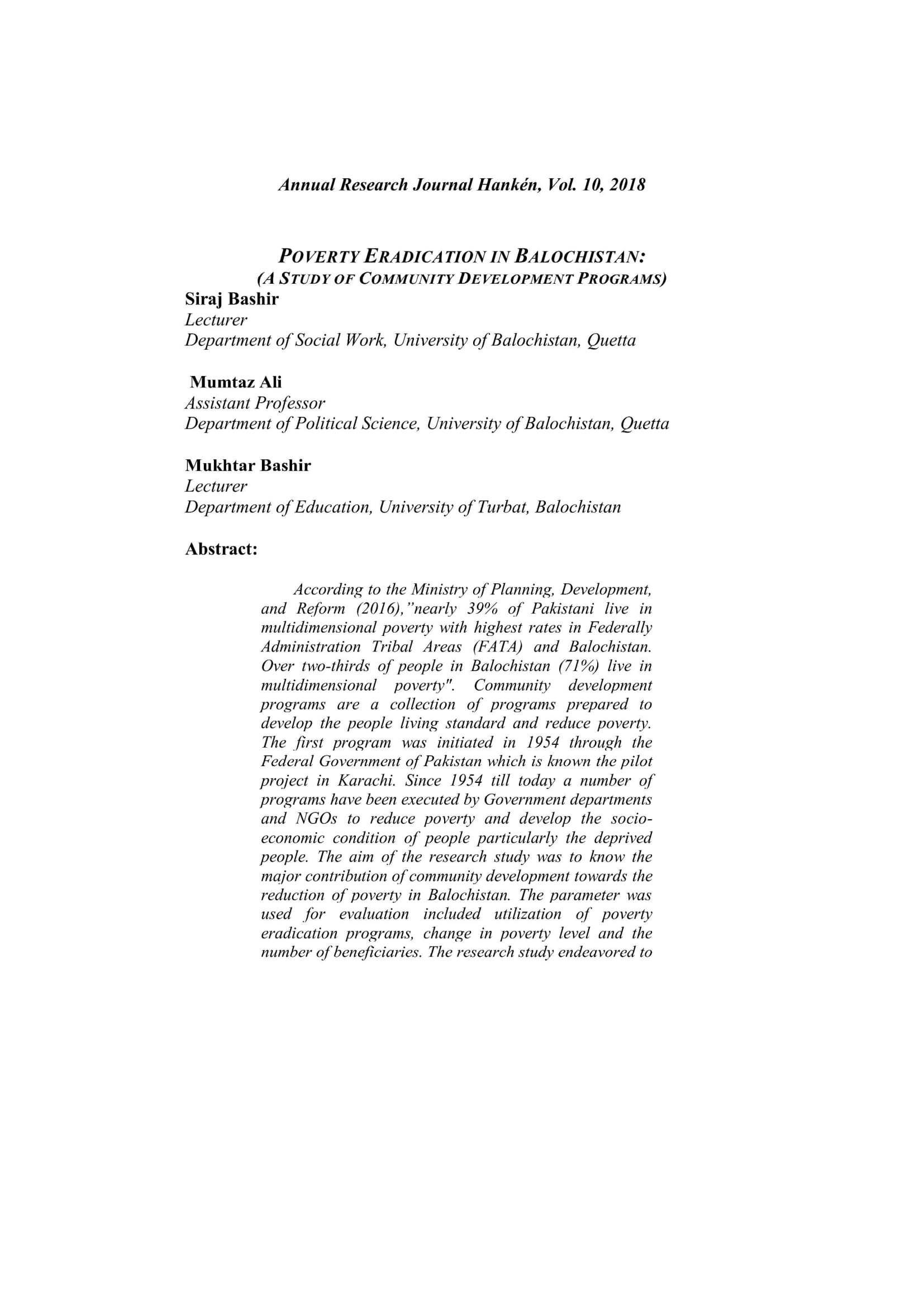POVERTY ERADICATION IN BALOCHISTAN: (A STUDY OF COMMUNITY DEVELOPMENT PROGRAMS)
POVERTY ERADICATION IN BALOCHISTAN: (A STUDY OF COMMUNITY DEVELOPMENT PROGRAMS)
Keywords:
Poverty Eradication; Community Development Programs, Balochistan.Abstract
According to the Ministry of Planning, Development,
and Reform (2016),”nearly 39% of Pakistani live in
multidimensional poverty with highest rates in Federally
Administration Tribal Areas (FATA) and Balochistan.
Over two-thirds of people in Balochistan (71%) live in
multidimensional poverty". Community development
programs are a collection of programs prepared to
develop the people living standard and reduce poverty.
The first program was initiated in 1954 through the
Federal Government of Pakistan which is known the pilot
project in Karachi. Since 1954 till today a number of
programs have been executed by Government departments
and NGOs to reduce poverty and develop the socioeconomic condition of people particularly the deprived
people. The aim of the research study was to know the
major contribution of community development towards the
reduction of poverty in Balochistan. The parameter was
used for evaluation included utilization of poverty
eradication programs, change in poverty level and the
number of beneficiaries. The research study endeavored to
Poverty Eradication in Balochistan:
(A Study of Community Development Programs)
67
analyzes the socio-economic consequences of these
programs on the communities where the poor life. The
study used interviews and document analysis. A sample of
50 beneficiaries was selected through a pre-structured
interview schedule for primary data. The finding of the
study may help to policymakers, poverty planner experts
and national and international organizations to take
serious and suitable actions for reducing
multidimensional poverty level in Balochistan.
References
Ayuub, S. (2013). Impact of microfinance on poverty alleviation. A
case study of NRSP in Bahawalpur of Pakistan. International
Journal of Academic Research in Accounting, Finance &
Management Sciences, 3(1), 119-135.
Aref, A. (2011). Perceived impact of education on poverty reduction
in rural areas of Iran. Life Science Journal, 8(2), 498-505.
Ahmed, M. (1993). Choice of a Norm of Poverty Threshold and
Extent of Poverty in Pakistan. The Journal of Development Studies,
Vol. XII-XII, Peshawar.
Aref, A. (2011a). Perceived impact of education on poverty
reduction in rural areas of Iran. Life Science Journal, 8(2), 498-505.
Abbas, M. T. E. Lodhi, K. Mehmood. and S. Muhammad.(2009).
An agricultural extension programs in Punjab. Pak. J. Life and Soc.
Sci., 7(1): 1-10.
Ahmed Ali Mengal, Zaheeruddin Mirani and Habibullah. (2014).
Historical Overview of agricultural extension services in Pakistan.
The Macro thence Review, 3(8):1-10.
M. Arif and Shujat Farooq.(2001).Poverty, inequality and
unemployment in Pakistan. Islamabad : Pakistan Institute of
Development Economics.
Abbas, M. T. E. Lodhi, K. Mehmood. and S. Muhammad.(2009a).
An agricultural extension programs in Punjab. Pak. J. Life and Soc.
Sci., 7(1): 1-10.
Charles R. Horton. (1958a). The Village Aid Program in Pakistan.
Karachi, Pakistan: United States Information Services Pakistan.
FAO. (2003). World Hunger and Poverty Facts and Statistics. UNO,
New York, UNO
Siraj Bashir et al.
Gimbi, T. A. P. (2002).community development, participation and
empowerment: conditions for rural development in South Africa.
The Social work practitioner-Researcher, 14(3):114-135.
Government of Balochistan.(2006). Provincial Disaster Risk
Management plan. UNDP publication, Quetta
GoP (2010) . Government of Pakistan, Planning Report, Pakistan,
Islamabad: Planning Commission
Ministry of Planning and Reform of (2006a) . Annual Planning
Report. Islamabad, Pakistan: Planning Commission
Mohammad, Khalid.(2006). Social work theory and practice with
special reference to Pakistan, Kifayat Academy, Karachi, Pakistan
Ministry of Planning and Reform of (2006) . Annual Planning
Report. Islamabad, Pakistan: Planning Commission
Phillips, Rhonda and Robert. H. Pittman., ed.(2008). An
introduction to community development, Taylor and Francis -elibrary, New York, USA.
Sarfraz, Qureshi, (2001). An Overview of Government’s Poverty
Alleviation Policies and Programs. Islamabad, Pakistan: Pakistan
Institute of Development Economics, Pakistan
Shireen, Rehmatullah.(2002). Social Welfare in Pakistan. Karachi,
Pakistan: Oxford University Press
The World Bank (2007).Review of The Asian Development Bank’s
Poverty Reduction Strategy. World Bank Publication, New York,
USA
United Nations Development Programs.(2010). Human
Development Report. New York, USA: Oxford University Press.
United Nations Development Programs.(2010a). Human
Development Report. New York, USA: Oxford University Press.
United Nations Development Programs.(2016). Human
Development Report. New York,: UNO Report.
Poverty Eradication in Balochistan:
(A Study of Community Development Programs)
Zeeshan Nasir.(2016). Poverty in Balochistan. Retrieved from the
website: http://www.bexpress.com.pk/2016/06/poverty-inbalochistan-2/UNDP.(2016). Pakistan’s new poverty index reveals
that 4 out of 10 Pakistanis live in multidimensional poverty.
Retrieved from the website:
http://www.pk.undp.org/content/pakistan/en/home/presscenter/press
releases/2016/06/20/pakistan-s-new-poverty-index-reveals-that-4-out-of-10-pakistanis-live-in-multidimensional-poverty.html


